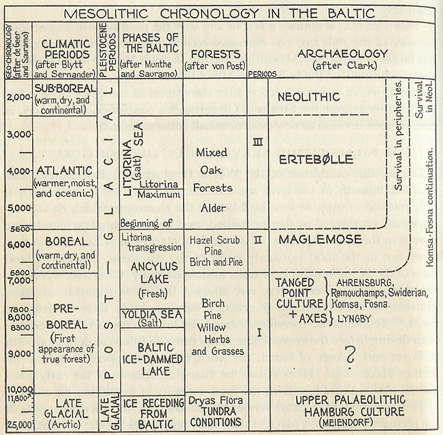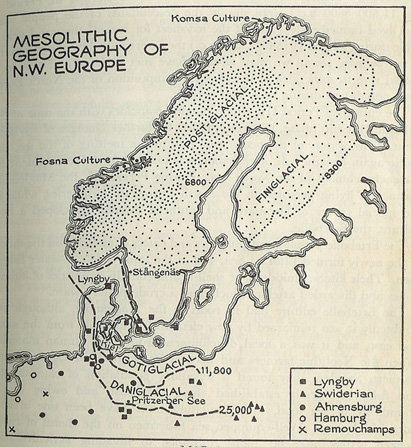|
(Chapter III, section 8)
Palaeolithic survivals in the northwest During the maximum of the Würm II glaciation, Palaeolithic man adapted himself, as we have seen, to the cold. Once so adapted it is only natural to suppose that he followed the climate to which he was accustomed northward as the ice melted, and as the animals which he ate moved in the same direction. Now the final glaciation of Europe was centered not in the most northerly point of the continent, but in the land mass of the Scandinavian Peninsula, and, apparently, the coasts of Norway (northern and western) were not affected by the last glacial advance. Human beings thus could penetrate Scandinavia in Late Palaeolithic times.32 Scandinavia, therefore, formed the last retreat of Old Stone Age man fleeing before the encroaching temperate conditions with their growth of forest and change of fauna; for when the ice disappeared he had no further place to go. Here at last the changing climate of the early postglacial period faced him with the final necessity of modifying his culture. The accompanying chart renders it
unnecessary to describe at length the changes which took place in the Baltic
region during the Mesolithic.33 In Period I, which lasted
from the end of Palaeolithic times until about 6800 B.C., following the de
Geer chronology, a number of local industries developed in northern Europe
from Palaeolithic origins. Thus the tanged-point cultures which stretched
from Belgium to the Ukraine, across the north of Germany and of Poland, are
derived ultimately from Aurignacian
In the very north of Scandinavia, during at least the latter part of Period I, tanged-point using people lived beyond the upper edge of the glacier, isolated, on a narrow coastal fringe, from the rest of mankind. To the south of the ice, in Denmark and the southern end of Sweden, as well in northern Germany, Palaeolithic survivors apparently invented the so-called “Lyngby" antler axe to cope with the encroaching forest. However, the most important culture of this period was the Ahrensburg,
In Boreal times, Period II (ca. 6800—5600 B.C.) the bed of the North Sea rose, and England and Scotland were joined to Denmark by dry land. At the same time the Baltic became a fresh-water lake, called the Ancylus. The entire North European plain, from England over to tile Urals, was Covered with a temperate forest. In this forest arose the Maglemose culture, which was derived from three elements: (1) the previous cultures of the north, especially the Ahrensburg and the “Lyngby axe” cultures, (2) the Magdalenian, already incorporated in the Ahrensburg, (3) the northward moving Tardenoisian, of eventual southern and southeastern inspiration. Hence, the inhabitants of northern Europe in Period I (ca. 11,800—6800 B.C.) were simply the descendants of the people who had lived immediately south of the ice-sheet for several thousand years, while during Period II (6800—5600 B.C.) they were joined by the vanguard of newcomers, whom we may already have met at Ofnet. These facts should give us some idea of the physical composition of the North European population during these two periods. The culture of Period III, which roughly coincides with the time of the Atlantic climatic phase, was conditioned by further changes of environment. The waters of the ocean rose due to the melting of the ice, the Baltic again became salt, and Britain was isolated from the continent by the encroachment of the North Sea. During Period III, the Maglemose manner of living persisted in the North European peripheries, while in the special center of Denmark and southern Sweden developed a new culture, the Ertebølle. The Ertebølle people were gatherers and eaters of molluscs on the shores of the newly formed Litorina Sea, and at the same time salt-water fishermen. Their kitchen-middens, or shell-heaps, contain quantities of animal bones and discarded artefacts, including a crude pottery ware. The Ertebølle culture had its roots in the Maglemose, although undoubtedly it was reinforced by new elements presumably from the south and east, and it was a local development from local human material. When the Neolithic farmers and herders finally reached Denmark and southern Sweden, they found a sedentary population of clam-diggers and fishermen firmly established along the coast, and owing to the abundance of sea food, this population must have been one of considerable density. Well-equipped sea fishermen on the shores of richly stocked waters offer far more resistance to invading agriculturalists than do hunters. The Ertebølle people were not driven out by their Neolithic neighbors, nor were they absorbed without trace into a larger population. In southern Scandinavia the old racial elements persisted alongside and in combination with the new, while in Norway the old tanged point makers lived on, to contribute technical methods to the Neolithic craftsmen. Period I is not represented by a single piece of human bone which can be dated with any pretense of accuracy. Period II, the Maglemose, is known from a number of skeletal finds, most of which, however, are in doubt. The only remains which are completely accepted and about which there can be no question are: (1) Stångenäs, near Roe, in the Parish of Bro, Bohuslän, Sweden; (2) Mullerp, Denmark; (3) Svaerdborg, Sweden; (4) Sandarna, Sweden.34 Of these, the only useful specimen for racial deductions of any consequence is that of Stångenäs, consisting of a brain case, a femur, and a tibia. These were the bones of an extremely tall man, 181 cm. in height,35 with long legs, particularly in the lower segments. The femur and tibia show all the peculiarities of form and development associated with Upper Palaeolithic man. The brain case, which is of extreme length, has an index of 71.9, a broad forehead, and prominent browridges. Fürst, who has studied this fragment carefully, assigns it without question to the Upper Palaeolithic racial group, especially to the central European Aurignacian.36 The Mullerp and Svaerdborg finds consist of a child’s mandible each,37 and a few broken fragments of other bones. That of Sandarna is limited to one long bone. For further evidence of the racial composition of Maglemose man, we must turn to northern Germany. In northern Germany, which forms a part of the North European Mesolithic area, a number of skulls, found under varying circumstances, have been attributed to all three Mesolithic periods. It is difficult, if not impossible, to verify the alleged age of any one of them. Among the most likely are two adult skulls, and one adult and three infantile mandibles, dredged from the bottom of the Pritzerber Sea, northwest of Brandenburg on the River Havel.38 Although they came from a layer of blue clay underlying peat on the lake bottom, the exact geological age of these formations cannot be established. Antler and bone artefacts recovered from the same clay belong to Periods I, II, and III of the Mesolithic.39 The two skulls are probably female, although the sex has not been conclusively determined. Both are of dolichocephalic type, with indices of 71; both have certain early European characters such as alveolar prognathism, strong browridges, high temporal crests, marked supramastoid ridges, and relatively large teeth. But the two differ in some respects; number one is large headed, short faced, and chamaerrhine, and number two of small capacity, very long faced, and mesorrhine. But both have only moderate bizygomatic diameters. A careful comparative study of these two crania places them both without difficulty into the female series of Upper Palaeolithic skulls; the greatest similarity is between number two and the female of Obercassel. Al. though the two Pritzerber crania differ widely in size and in face form these differences can be matched in the Upper Palaeolithic group. The adult male mandible found with the Pritzerber crania is large, wide, high, and has everted gonial angles; it belongs to the same racial category as the crania. Typologically, these Pritzerber See remains are Mesolithic, for the two skulls could be female counterparts of Stångenäs, but to which of the three sub-periods they belong, we cannot tell. The Anthropological Institute of Kiel University possesses a number of skulls from Schleswig-Holstein of purported Mesolithic age, most of which were removed from Kiel Harbor or the Kaiser Wilhelm Canal, during dredging operations. Others were simply dug up from peat deposits by farmers draining their bogs. Dates of varying accuracy may be assigned to seven of these specimens; all seven belong to the physical type of which Stångenäs may be a male, and the Pritzerber See crania female, examples.40 Four of them have been dated by pollen analysis;41 three being assigned to the earliest Litorina transgression, and presumably to the very end of Period II, or Maglemose, archaeologically; and a fourth to full Litorina, thus probably Period III, or Ertebølle. The other three specimens, including the Ellerbek skull, which was dredged from submerged land in Kiel Harbor, may be dated, very tentatively, only by their associations with implements. Thus, so far, we have found only dolichocephalic crania of European Upper Palaeolithic type associated with early post-glacial Mesolithic remains in northern Germany, as well as in Scandinavia. But there are other skulls, of dubious Mesolithic association, which are brachycephalic. These include the skulls of Plau, Mecklenburg; Dömitz, from the bed of the Elbe; and Spandau, from the mouth of the Spree. All three could fit very easily into the brachycephalic group from Ofnet, and if they are not Mesolithic, show the northward movement of that type in later times.42 Before concluding this survey of racial associations in the Mesolithic of northwestern Europe, we must not fail to mention the parallel situation in the British Isles. Briefly, during the Upper Palaeolithic there are no true Solutrean or Magdalenian deposits in Britain, but the Aurignacian continues, to develop into an early Mesohthic culture called Creswellian. This in turn is later influenced by Azilian cultural diffusion from western France and northern Spain. The Aurignacian which came to England, and from which Creswellian developed, apparently came from central Europe.43 During the Mesolithic, a northern extension of Creswellian, strongly mixed with Azilian, extended to southwestern Scotland, where it has been found in the Oban caves of Argyllshire. The deposits of some of these caves date from Late Atlantic time, subsequent to the maximum Litorina transgression, during which period the caves were formed. This would roughly correlate the remains which they contained with Period III in Scandinavia. We must remember, however, that, although a few stray Maglemosian finds have been made in eastern Scotland, the land connecting Scotland with Denmark in the Boreal period had since sunk below the North Sea, and skeletal material from the Oban caves cannot be closely related in a cultural sense to that from Scandinavia. During the last century, a number of these caves, when excavated, yielded skeletal material dating from the Late Mesolithic through the Bronze and Iron Ages into modern times. One of the sites, the MacArthur cave, contained some artefacts which have been recognized as Azilian,44 as well as two male skulls, of which one at least is probably contemporaneous with the deposit.45 This specimen, called skull B, is very similar to the Stångenäs fragment in Sweden, with nearly identical vault dimensions, a cranial index of 70, a broad forehead, and heavy browridges. The sagittal arcs of the skull, the breadths and heights of the orbits, the depressed root of the nose, the breadth of the face, and the height of the mandible, are all typical of the purely long-headed variety of the Upper Palaeolithic European racial group. From the photographs46 it is possible to make further observations, and even to reconstruct tentative values of additional measurements. The bizygomatic facial breadth was greater than the breadth of the vault, and the nose was leptorrhine. Oban man is, in short, an ideal
example of the central European Aurignacian physical type. As far as this
one specimen is concerned, the initial Upper Palaeolithic invasion of the
British Isles was still represented, many thousands of years later, by its
original racial type.
32 Boë, J., and Nummedal, A.,
Le Finnmarkien.
|

